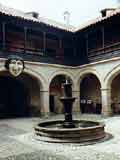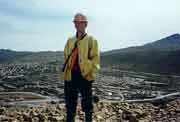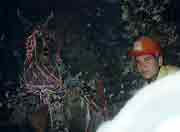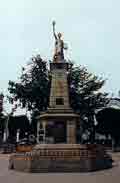|

A beautiful outside view of the front door
“Casa Real de la moneda” 03/2002
Casa Real de la Moneda
The Case Real de la Moneda is
a truly incredible building.
Built in
1572 under the viceroy Toledo. To enter this beautiful building
you must take a tour, which I might add is well worth the cost of 20
pesos. Inside you will find
many Bolivian treasures including the first Locomotive ever used in
Bolivia.
Due to the wealth of Potosi
at the time of construction, the Casa Real cost more than 30 times more
than any other building of it’s magnitude. The best Architects and materials were brought in from
around the world sparing no expense.

The front courtyard, the
mask of Bacchus was hung in 1865 by Frenchman Eugenio Martin Moulon for
reasons unknown
“Casa Real de la Moneda” 03/2002

The first coins ever used as currency for Bolivia
as a Independent Country
“Casa Real de la Moneda 03/2002
|
I am rich Potosi…
The treasure of the world…
And the envy of kings …
Potosi
Potosi
founded in 1545 was once the wonder and capital of the world. With the once largest Silver
mine in its backyard, Potosi became the richest city in the world, despite
is altitude of 4090m. Potosi’s
wealth continued into the late 19th century, until the decline
of it’s silver mine started to change the face of this once illustrious
city. The city that had
streets literally made of silver, has now become one of the poorest in
South America.
I
stayed in Potosi for only 2 days, and found. Although there is much history, the high altitude and
great poverty didn’t leave much feeling for relaxation.
You
can actually take tours of the mines in the famous Cerro Rico. Many of the same tunnels are still
in use. Once in the mines, you
can see first hand the absolute brutal working conditions. Miners, only have the coca leaf for
food and work 12 hr days with no rest or sunlight.

Me on top of the famous
“Cerro Rico”
Potosi 03/2002

Inside the Cerro Rico standing next to “El Tio”
El Tio, is known as the devil in Aymara
culture. These
sacrifices/altars are made for “El Tio” so he will protect miners while
they are deep in the earth.
Potosi 03/2002

Plaza 6 de Agosto
Potosi 03/2002
|